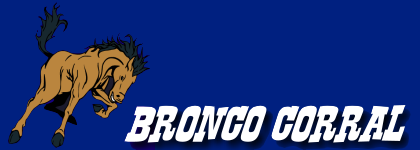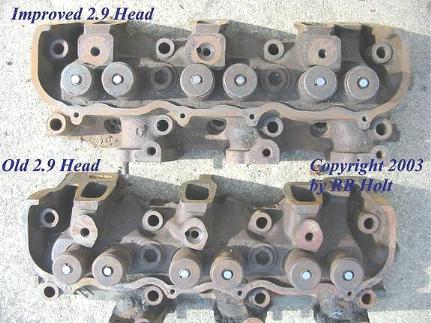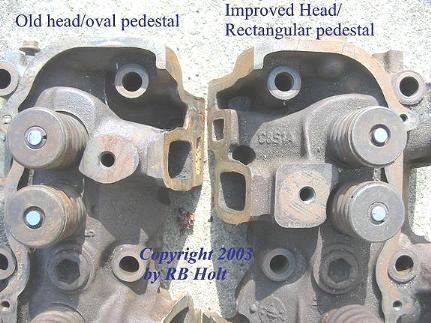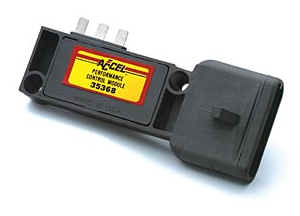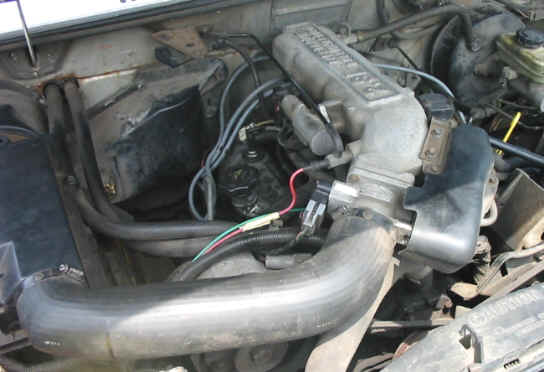
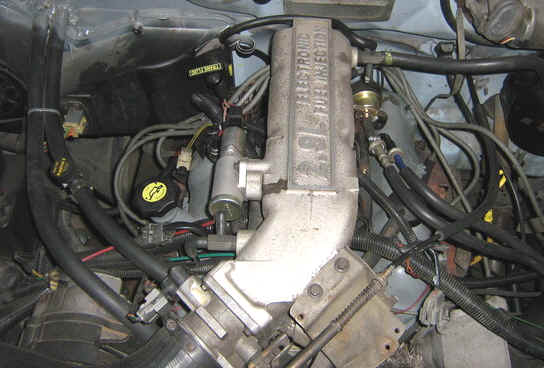
The Ford Cologne 2.9L V6 is a 60° cast iron block V6 engine built by the Ford Motor Company in Cologne, Germany, hence the name. Over the years, the Cologne V6 was available with engine displacements of 1.8, 2.0, 2.3, 2.4, 2.6, 2.8, 2.9 and 4.0 litres. All except the Cosworth 24v derivative and later 4.0 litre SOHC engines were pushrod overhead valve engines, with a single camshaft between the banks.
Originally, the Cologne V6 was installed in cars intended for Germany and continental Europe, while the British “Essex” V6 was used in cars for the British market. Later, the Cologne V6 largely replaced the Essex V6 even for British-market vehicles. These engines were also used in the United States, especially in compact trucks.
The 2.9 L shares the same basic design as the 2.8 L model, bar a few subtle differences. The camshaft is chain-driven rather than gear driven, so it rotates in the same direction as the crankshaft. The arrangement of the exhaust valves is different, eliminating the “Hot-Spot” that existed on the 2.8 L model. The cylinder heads also sport a more conventional three-port exhaust manifold. Output was rated at 140 hp @4600 rpm for the Light trucks (1986-92 Ranger & 1986-90 Bronco II) and 144 hp @4800 rpm for the Merkur Scorpio in the US market and anywhere from 150 to 160 hp for the European Market.
Bore was 93 mm (3.7 in) and stroke was 72 mm (2.8 in) for a total displacement of 2.9 L (2935 cc/177 in³).
In Europe, this engine was commonly fitted with the Bosch L-Jetronic fuel injection system, married to Ford’s EEC-IV engine management. Because of this difference over the 2.8 L model, this version was a more popular candidate for after market modification (typically turbocharging) from such well known companies as Janspeed and Turbo Technics.
North American 2.9 Reliability:
The North American version of this engine suffered from several serious reliability issues over its lifespan.
Cylinder head cracking was common in early models. Compared to the relatively stout European heads, the North American 2.9 had apparently been subject to a reduction of material around the valve stem guides and rocker shaft mounting pedestals. Some engines would suffer from this failure after overheating only once. Most common symptoms are clean spark plugs, white exhaust smoke when warm, low compression on one or more cylinders, and “snot” on the oil cap or dipstick. Sometimes the “Snot” can just be condensation, so make sure the Engine is warm before checking. The best course of action is to drain the oil, pull the heads, and have them magnafluxed to make sure you have a crack, if you do have a crack, DO NOT RUN THE TRUCK, coolant in the oil toasts crankshaft bearings, requiring a total rebuild. If the truck isn’t run to long than you can probably get away with just heads.
The cylinder heads underwent a redesign for the 1989 model year, receiving additional material in problem areas, largely eliminating this specific failure. These head casts are commonly printed with the “89TM” designation. After-market heads are also available from World Products, with similar design improvements to the early OEM design.
Note the straighter valve cover mating surface on the improved heads. That is why old-style valve covers tend to leak on the newer heads. New valve covers have a turned-up flange, while the old-style valve covers have a turned-down flange. The important feature, as far as resistance to cracking is concerned, is that the improved heads are identified by the rectangular shaped rocker pedestals, while the old-style heads have oval pedestals.
Additionally, oiling problems were common, and added to the poor reputation of the North American 2.9. Many poorly maintained or high mileage engines exhibit serious valve train noise. This problem is due to a number of design faults. Valve train oil pressure was entirely dependent upon a supply fed through the two center cam bearings. Even slight bearing wear could cause complete loss of oil pressure to the hydraulic valve lifters, rocker shaft, and rockers. Excessive internal “bleeding” through the half-moon camshaft thrust plate also contributed to this, though this can be remedied by reinstalling the thrust plate in an upside-down position. This condition is sometimes mistaken for ticking fuel injectors. This condition isn’t a cause for alarm unless it does it very loudly or after long freeway trips. If it does have the oil pressure checked, it could be low.
In the event that a cylinder head crack occurs, coolant can often enter the crankcase, contaminating the oil. This quickly led to cam bearing damage, triggering valve train oil pressure loss. As a result, these two design faults led to catastrophic engine failure in many North American 2.9s.
Valve covers have been known to leak. Other than making the engine look nasty and smell nasty, these pose no danger. Some claims have been made of the motor catching fire because so much oil leaked on the exhaust, but this is rare. Replace with Fel Pro “Rubber” or Fel Pro “Blue” and leaks should be taken care of.
Regardless of these problems, many of these engines are still on the road in the US, and when maintained properly, are highly reliable powerplants. Use of synthetic oil and proper cooling system maintenance is essential if owners of early-model 2.9s wish to avoid trouble.
Ford Bronco II:
The 2.9L V-6 was offered in the Ford Bronco II from 1986-1990.
| Specifications | |
| Engine Family | Cologne |
| Engine Displacement (Cubic Inches) | 177 |
| Cylinders | 6 |
| Arrangement of Cylinders | “V” Shape |
| Bore x Stroke | 3.66 x 2.83 |
| Compression Ratio | 9.0:1 |
| Valvetrain | Pushrod Overhead Valve |
| Fuel System | MPFI (Multiport Electronic Fuel Injection) |
| Fuel Pressure | 30-40psi |
| Horsepower | 140hp @ 4600rpm |
| Torque | 170hp @ 2600rpm |
| Oil Pressure | 20psi @ warm Idle 55psi @ 2000rpm |
| Tune Up | |
| Spark Plug | AWSF-42C |
| Spark Plug Gap | 0.044 |
| Ignition Timing | 10 degrees BTDC |
| Firing Order | 1-4-2-5-3-6 |
| Distributor Rotation | Clockwise |
| Capacities | |
| Oil Capacity With Filter Change | 5.0 quarts |
| Oil Capacity Without Filter Change | 4.0 quarts |
| Cooling System Capacity (Quarts) | W/AC- 7.2 / W/O AC 7.8 |
| Torque Specifications | |
| Cylinder Head | Torque in 3 steps [1st (22ft-lbs), 2nd (51-55ft-lbs), 3rd (Turn 90 degrees)] |
| Main Bearing Bolts | 65-75ft-lbs |
| Rod Bearing Bolts | 19-24ft-lbs |
| Crankshaft Pulley Bolts | 85-96ft-lbs |
| Flywheel to Crankshaft Bolts | 47-52ft-lbs |
| Intake Manifold | 15-18 ft-lbs [5-steps (hand start & snug) (3-6) (6-11) (11-15) (15-18) (Repeat 15-18 after warm up)] |
| Exhaust Manifold | 20-30ft-lbs |
| Valve Specifications | |
| Seat Angle Degree | 45 |
| Face Angle Degree | 44 |
| Spring Test Pressure | 143lbs @ 1.22in |
| Spring Installed Height | 1.58-1.61in |
| Stem to Guide Clearance Intake | 0.0008-0.0025in |
| Stem to Guide Clearance Exhaust | 0.0018-0.0035in |
| Stem Diameter Intake | 0.3159-0.3167in |
| Stem Diameter Exhaust | 0.3149-0.3156in |
| Crankshaft Specifications | |
| Main Bearing Journal Diameter | 2.2433-2.2441in |
| Main Bearing Oil Clearance | 0.0008-0.0015in |
| Shaft End-Play | 0.004-0.008 |
| Thrust on No. | 3 |
| Connecting Rod Specifications | |
| Journal Diameter | 2.1252-2.1260in |
| Oil Clearance | 0.0006-0.0016in |
| Side Clearance | 0.004-0.011in |
| Piston & Ring Specifications | |
| Piston to Bore Clearance | 0.0011-0.0019in |
| Ring Side Clearance Top Compression | 0.0020-0.0033in |
| Ring Side Clearance Bottom Compression | 0.0020-0.0033in |
| Ring Side Clearance Oil Control | Snug |
| Ring Gap Top Compression | 0.015-0.023in |
| Ring Gap Bottom Compression | 0.015-0.023in |
| Ring Gap Oil Control | 0.015-0.023in |
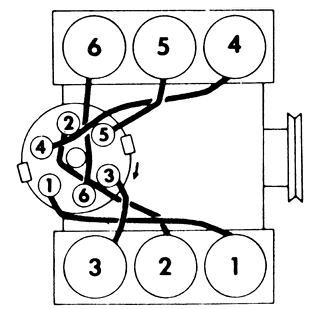
Firing Order 1-4-2-5-3-6 / Distributor Rotation – Clockwise
Known Problems
Cylinder Heads:
The 1986-1988 heads were known for cracking. Usually caused by overheating the engine. The cylinder heads underwent a redesign for the 1989 model year, receiving additional material in problem areas, largely eliminating this specific failure. These head casts are commonly printed with the “89TM” designation.
Most common symptoms are clean spark plugs, white exhaust smoke when warm, low compression on one or more cylinders, and “snot” on the oil cap or dipstick. Sometimes the “Snot” can just be condensation, so make sure the Engine is warm before checking.
Best course of action is to park the truck, drain the oil, pull the heads, and have them magnafluxed to make sure you have a crack. If you do, do not run the truck. Coolant in the oil destroys crankshaft bearings requiring a total rebuild. If the truck isn’t run to long than you can probably get away with just new heads.
Valvetrain Ticking:
Ticking lifters can sometimes be mistaken for ticking fuel injectors. This condition isn’t a cause for alarm unless it does it very loudly or after long freeway trips. If it does, have the oil pressure checked. It could be low. A cause of the ticking is likely to be clogged rocker arm shafts that are restricting oil flow, thus causing lifters to wear out and tick because of poor oil circulation.
Valve Cover Gaskets:
Other than making the Engine look nasty and smell nasty, these pose no danger. Some claims have been made of the motor catching fire because so much oil leaked on the exhaust, but this is rare. Replace with Fel Pro “Rubber” or Fel Pro “Blue” and leaks should be taken care of.
TFI Module:
Your Bronco II is stalling/dieing or sputtering when hot but runs when it cools off. This can be caused by a faulty TFI and the biggest culprits are heat. Another culprit can be a wire grounding out. Problematic TFI’s can give off codes 14 (PIP) and 18 (SPOUT).
To learn more about the problem and how to deal with it, click HERE.
Improving Performance
Cylinder Heads & Pistons:
Removal:
Click HERE for information on removing your cylinder heads.
Head Porting:
Port your upper and lower intake. The intakes don’t line up diameter to diameter. Porting opens this up and allows better flow. Knife edge the intake side of the throttle body to remove the front lip. You can use a Dremel tool to grind, sand and buff this area to obtain a smooth airflow in to the engine. You can also mill down the butterfly to blend in to the shaft for a smoother air flow.
For details on how to port your heads, click HERE.
Clearwater Cylinder Head Company
Clearwater Cylinder Head Company offers an economical replacement cylinder head for the Ford 2.9L
Tom Morana
Tom Morana offers rebuilt 2.9L cylinder heads in (3) stages of performance modifications.
Tom Morana also offers forged pistons for the 2.9L.
2.8 Pistons:
There has been talk about using 2.8L flat top pistons in the 2.9L engines to increase compression and hopefully increase horsepower. Supposedly, if you would need to get .030 oversize 2.8L pistons and bore the 2.9 block accordingly. It should raise the compression ratio to 10-10.5:1 and would require at least premium gasoline. The increase in power mathematically would be roughly 2-4% per point in compression increased so that being said with the 2.9L at 8.5:1 increasing the compression with those pistons to 10.5:1 you would yield a maximum of 8% increase in power.
Induction:
Note About Speed Density:
The 2.9L Bronco II’s have a Speed Density fuel injection system. The speed density system is best described as a calculation procedure used by the electronic engine control (ECC) module that involves predetermined operating parameter values, volumetric efficiency tables, pre-measured airflow-through-the-engine values, and the known volume of fuel delivery required per combustion event for a single cylinder.
Management of fuel and spark functions is based mainly on a predetermined range of preprogrammed data and also on real-time feedback data from an array of sensors. The “speed” signal is based on the calculated volume of a single cylinder. The “density” signal is a function of temperature and pressure measurements. To determine an engine’s fuel delivery requirements, the speed density system infers airflow from several monitored sources, including engine speed (in RPM), intake manifold absolute pressure (MAP, to determine load), manifold absolute temperature (MAT), throttle position, the oxygen content of the exhaust (O2 Sensor), engine coolant temperature and battery voltage.
There is no airflow sensor (airflow meter) in the speed density system. Signals form the manifold absolute pressure sensor relate operating conditions that are translated into relationships (engine-speed-to-load-to-throttle position, for example). The EEC then compares this data to ideal data curves based on the engine’s volumetric efficiency. The speed density computer is preprogrammed for the desired fuel, ignition, and EGR characteristics, and it makes continuous (metering, timing, and cycling) adjustments based on those pre-mapped relationships.
Basically, speed density systems are accurate because the data within the control module (e.g. computer) is based around the specific engine configuration. For instance, the speed density computer in our Bronco II contains spark and fuel tables specific to the Bronco II 2.9L engine. Thus speed density systems are not adaptable to significant changes in an engine’s volumetric efficiency. One you start adding cams, heads, etc. the computer cannot compensate properly because it is operating around a pre-set range of air volume which that particular engine will consume.
Early 2.9L Throttle Bodies
1986-1987 2.9 throttle bodies were much larger than those produced from 1988 and up. 1986-1987 throttle bodies measure at 58mm. Making them a direct bolt on replacement. (The 1986-1987 TB are large enough to fit a tennis ball!)
5.0L Throttle Body to 2.9L Intake Conversion
This page is basically an information page about the process involved in adapting a throttle body (TB) from a 1986-1993 Ford Mustang or an equivalent aftermarket piece (BBK, Edelbrock, or Ford Motorsport) to the upper intake of a 1986 – 19?? 2.9L Bronco II V-6. Click HERE for details
Tom Morana Throttle Body
Tom Morana offers a throttle body intake that is said to increase 20 more horsepower. They offer 54mm, 60mm, and 65mm throttle bodies.
MAF Conversion
Convert from a standard speed density controlled 2.9L V6 engine to a MAF (mass airflow) controlled system. Click HERE for details.
Fuel Injectors:
Install 19 lb injectors from a 5.0 V-8.
Plenum Spacers
Plenum Spacers can be installed to help cool the incoming air.
K&N Air Filter by Mike Dehosse:
I found a parts store that sold K&N filters. I measured the outside diameter of my throttle body where the hose attached. It’s 2 3/4-inches in diameter. I told the parts guy I wanted a cone shaped K&N filter that clamped on to a 2 3/4-inch flange. The filters that would work had a can shape. I knew that shape would interfere with the radiator hose so we found a filter that had an angled mount, K&N part number RU-1460. A K&N filter can also be mounted at the airbox end of the intake hose by inserting a small tube, and then clamping the hose, tube, and K&N filter together.
When removing the factory airbox you will also remove the hot air hose coming from the exhaust manifold and a vacuum hose. The vacuum hose should be removed and plugged at the engine. You should keep these pieces to bolt back on later if you live in an area with emissions tests / inspections.
Camshafts:
Note: The Ford 2.9 stock camshaft profile is: Valve Lift (Intake / Exhaust) .358 / .370 .050″ Duration (Intake / Exhaust) 196 / 200 Lobe Separation Angle 102 / 117
Thoughts on choosing a cam:
Short duration cams with wider lobe separations usually yield much flatter torque curves
Longer rod motors prefer a shorter duration cam with wider lobe separation
Longer duration cams require tighter lobe separation to have any power off the corner. (Not usually a preferable combination in 2 bbl classes)
Stock exhaust manifolds or a highly restricted exhaust usually respond well to shorter exhaust duration and wider lobe separation. Power increases are most evident at higher rpm where exhaust backpressure is greatest and reversion is most prevalent
Most unported heads approach 85 or 95 % of peak flow at .400 to .450 lift and do not need or want a maximum valve lift over .540 to.555. Often a low cam lift with 1.65 or 1.7 ratio rockers is very helpful on the intake side as long as lift is kept to about .550. Exhaust is less critical with 1.5 or 1.55 being the most popular
Dyno testing doesn’t test drivability or throttle response of the engine
The important numbers on a dyno sheet are about a thousand RPM above and below peak torque and peak horsepower. Peak numbers are for bragging purposes and high peak numbers do not win races
The benefit of high ratio rockers is faster valve movement and the added lift is frequently detrimental in unported heads. It often helps to utilize a lower cam lift with high ratio rockers
Changing the valve lash is a good way to get an indication of which way to go for your next cam change. You won’t hurt anything by going too tight but too loose will let the valves slam shut causing damage to valves and seats. .004 to .006 loose is usually OK
Look at the Intensity numbers to get an idea as to how radical the profile is. Lower numbers are more radical but anything less than 27 or 28 degrees major intensity may be very hard on the valve train. Our 26-degree SXTL profiles are a notable exception to this
Camshaft intensity is a measurement term coined by Harvey Crane to compare ramp characteristics of camshaft profiles.
Hydraulic Intensity is the difference between the .004 duration and the .050 duration
Minor intensity is the difference between the .010 duration and the .050 duration
Major intensity is the difference between the .020 duration and the .050 duration
Lower numbers indicate more aggressive profiles but too low can be too radical and lead to noisy valve train and even to broken parts
Camcraft Cams
Camcraft made an RV style camshaft for the 2.9L. Check out https://www.camcraftcams.com/
Tom Morana
Tom Tomorana carries a. Check out www.moranav6racing.com/
Colt Cams
Colt Cams also offers a camshaft for the Ford 2.9L . Check out www.coltcams.com
Rockers
Upgrade to Free Floating Rockers
Tom Morana carries roller rockers for the 2.9L. Check out www.moranav6racing.com/
Ignition
TFI Harnesses
MSD offers these wiring harnesses to simplify the installation of a MSD 6 series box on late model vehicles. The harnesses plug in between the ignition coil and the factory coil connector. Four wires with corresponding colors and matching connectors then connect directly to the MSD 6 wires. These harnesses reduce the installation time, reduce or eliminate cut wires, and allow you to quickly convert back to the factory ignition.
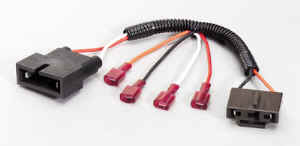
MSD-8874 Shown Above
The MSD to Ford TFI Coil Harness is designed to provide a splice-free and simple installation of an MSD Ignition Control to Ford vehicles equipped with a TFI Coil. On MSD 6 & 7 Series Ignitions all of the wires connect to the corresponding colored wires. MSD 7 Series Ignitions share the same color wires.
1. Disconnect the connector from the coil and connect it to the MSD PN 8874 Harness.
2. Connect the other end of the Harness to the Coil.
3. Connect the four wires of the Harness to the MSD Ignition Control.
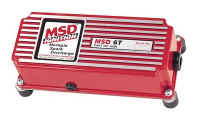
MSD Ignition Box Shown Above
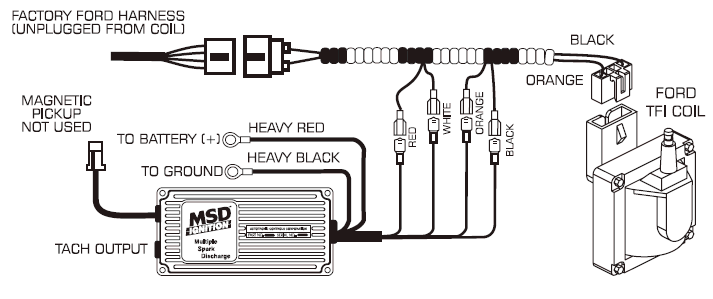
Replacement Coils
Summit Racing carries replacement TFI ignition coils.
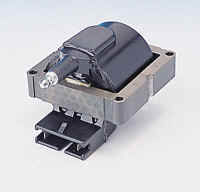
Moroso P/N MOR-72360
MSD P/N MSD-8227
Pertronix P/N PNX-D3003
ProForm P/N PRO-66959C
Hypertech P/N HYP-4064
TFI Ignition Modules:
Summit Racing carries Accel and PerTronix TFI Ignition Modules.
PerTronix P/N D2010
Accel P/N 35368
Accel P/N 35368 Shown Above
ACCEL control modules provide high coil output & superior reliability. Dwell circuit ensures long coil charging. Current circuit protects from overheating. Resists false triggering from RFI sources. Distributor and remote mounts available.
Available at Summit Racing.
Jegs carries TFI ignition modules for the 2.9L as well.
Exhaust:
Install some Pacesetter headers.
There are no exhaust kits for the Bronco II. You’ll have to fabricate your own. It’s best to go to a shop that deals strictly with exhaust systems. They’re usually good at know what size pipes and mufflers will give your vehicle the best flow and sound.
Miscellaneous:
Install a 180 degree thermostat
Use synthetic fluids to prevent friction/horsepower loss
Replace your mechanical fan with a 16-Inch electric unit to reduce engine drag
Set your timing at 12 degrees advance and use at least 89 octane fuel.
Install 8mm spark plug wires.
Install Motorcraft Spark Plugs: 42 heat range for stock ignition and 44 for advanced timing
Install a Jet Performance Module # 88704 for automatics, or 88705 for manuals.
** If your looking for better acceleration then consider increasing your ring and pinion ration by the next size. (Example – Swap 3.73’s for 4.10’s). This is one of the first step Detroit did when producing muscle cars. A normal rear wheel drive passenger car will run about 2.73 gears in the rear end. The manufacturer will take this car and install 3.73’s with a dual exhaust and ‘cosmetics’ and call it a ‘Muscle Car’.
KunzKorner
Pat Kunz was a great contributor to online enthusiasts looking for engine mods to their Ford 2.9L engines and was writing Tech Tips in 1998/1999. View Pats Kunz Korner HERE for more tips.
